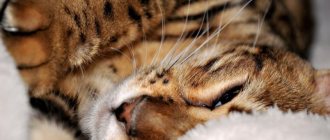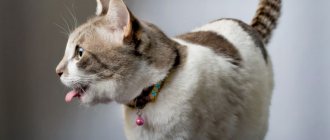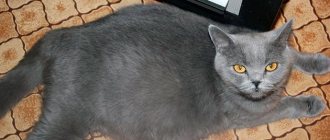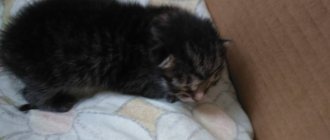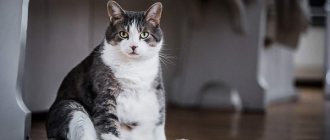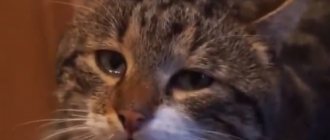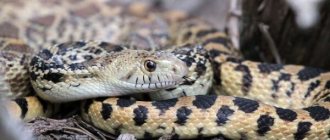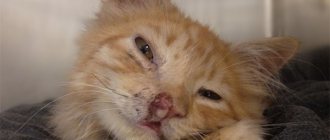If your cat squints one eye, a number of different factors may be to blame. This sign indicates that the kitten has discomfort and pain in the visual organ. The condition when a cat squints and closes its eye can be accompanied by discharge from the organ of vision, as well as suppuration. In such a situation, it is important not to delay a visit to the veterinary clinic.
Causes
It should be noted right away: in most ophthalmological diseases of cats and humans, the pathogens are the same. Therefore, after touching your pet's eyes, you should wash your hands with special care.
Squinting indicates that the animal is experiencing pain or discomfort, which is caused by the following reasons:
- infectious diseases;
- injuries;
- inflammation of the third eyelid;
- glaucoma.
Clinical symptoms, diagnostic methods, treatment and prevention vary depending on the cause. Therefore, each disease is described in a separate section.
How to treat lacrimation at home?
It is important to note that you should not put human medications in your pet's eyes. Firstly, they are ineffective for animals, and secondly, exceeding the dosage can have a detrimental effect on the cat.
As an additional means to the main treatment, you can treat with decoctions of herbs, such as chamomile, sage or calendula. Also, instead of herbs, you can use strong tea leaves or a weak solution of manganese. Such washing helps to get rid of pus in the pet’s eye, stop inflammation, and heal the affected eyeball.
Contagious diseases
Damage to one eye is typical for the following infectious diseases:
- herpes;
- chlamydia;
- demodicosis;
Herpes
Blepharospasm
A viral disease better known as rhinotracheitis. An acute course is typical for unvaccinated kittens from two to three months. Chronic disease occurs in adult animals during periods of weakened immunity. At the initial stage, blepharitis develops, which is characterized by inflammation of the eyelids. They stick together and blepharospasm develops.
Subsequently, the second organ of vision is also affected. A characteristic sign of rhinotracheitis is ulcers on the cornea of the eye. Self-medication is dangerous because it can cause loss of one or both eyes, bronchopneumonia, constipation, and damage to internal organs. Treatment is prescribed by a veterinarian. To prevent rhinotracheitis, kittens and sexual partners are vaccinated before mating.
Chlamydia
The bacterial infection primarily affects kittens from 1 to 3 months. At this time, death is possible. With chlamydia, one eye first becomes inflamed, then the second is affected.
Be sure to read:
What can cause a cat's cheek to swell: causes of swelling and puffiness on the face under the eye
Chlamydia affects one eye first
Treatment is prescribed by a veterinarian. If ophthalmic ointments or drops are used, two eyes should be treated, even though one of them looks healthy. Prevention consists of proper feeding, satisfactory living conditions and vaccination with a polyvalent drug against chlamydia and other dangerous diseases of cats.
Demodicosis
Demodicosis glasses
The pathological process is caused by the activation of the subcutaneous mite due to a weakening of the immune defense. With asymmetrical lesions, demodectic glasses are formed around one of the eyes. Soreness causes the pet to squint one eye.
Treatment consists of treating the affected surface with external insecticidal and acaricidal agents. If the pathological process goes far, inflammation occurs.
As the affected area heals, it scars and squinting becomes a lifelong cosmetic defect. Prevention consists of proper feeding, as well as applying insecto-acaricidal drops Spot on to the healthy, intact skin of the withers, which protect the pet from fleas, helminths, cutaneous and subcutaneous ticks.
Why do cats close their eyes when they sit?
Cats close their eyes when they sit because they are in a state of relaxation. Cats who are comfortable in the presence of their owners are happy to relax with their eyes closed because they know they are safe.
They are also likely to be in slow wave sleep (SWS), which is the most superficial form of rest. This stage of sleep usually precedes the rapid eye movement stage of sleep, which is much deeper.
However, these stages of sleep are important for conserving the large amounts of energy cats need to hunt, play, and roam.
During slow-wave sleep, cats lie with their heads raised and paws tucked. Sometimes they also sleep sitting up, their muscles tense to keep them upright and still.
Although cats look like they are sleeping with their eyes closed, they are fully aware of what is happening around them. As a result, you will see their ears rotate back and forth as they hear sounds in their environment.
This alertness allows them to attack or flee when they need to react to danger. Cats exhibit this sleep behavior several times during the day, especially when it's cold and rainy outside and they have nothing else to do.
© shutterstock
Injuries
Unilateral damage most often occurs in a fight, and also occurs when a cat is stung by a bee. One side swells and the eye closes. A pet injures its eye while chasing prey, or when a splinter gets into the soft tissue or a small solid particle gets into it. Ophthalmic drops are used for treatment.
If the use of an external remedy does not lead to the desired results. Seek veterinary help.
Symptoms of hair loss
The emergence of the third eyelid beyond its normal boundaries, as well as its swelling, is a serious cause for concern. The non-physiological position of the membrane is a signal of certain diseases or injuries. In addition to the fact that the third eyelid becomes visually noticeable, other symptoms are noted. In cases where the causes of the unpleasant phenomenon are directly related to the eyes, redness of the conjunctiva occurs, the release of an increased amount of tear secretion, the appearance of purulent discharge in the corners of the eyes, and involuntary spasm of the orbicularis oculi muscle. A burning sensation in the eyes affects the cat's behavior. She tries to avoid the light and scratches her eyes with her paws.
If the problem is caused by systemic or infectious diseases, then the cat will exhibit symptoms characteristic of such conditions. These include general weakness, decreased activity, loss of appetite, and increased temperature. If the problems are related to the digestive tract, then frequent or episodic vomiting and diarrhea are possible. As the process drags on, the animal loses weight and the condition of its coat deteriorates. In rare cases (with Horner's syndrome), paralysis or paresis of the limbs and facial nerve occurs.
Sometimes third eyelid prolapse is confused with lacrimal gland prolapse because these conditions are visually similar. To distinguish these problem situations and understand the solutions, it’s worth watching this useful video:
Inflammation of the third eyelid
The nictitating membrane in an active cat is invisible. The transparent membrane protects the eye sphere from dust particles and debris. Due to the inflammatory process, the membrane hypertrophies and no longer fits under the eyelids.
Most often, unilateral inflammation is observed due to the following reasons:
- infectious diseases;
- allergic reactions;
- injuries;
- internal non-communicable diseases;
- congenital predisposition.
Most often, Persians, Britons, as well as mixed breeds and cats of related breeds get sick. Treatment is surgery. To prevent inflammation of the eyelid, you should purchase a pet from trusted breeders and not engage in spontaneous selection.
Be sure to read:
Third eyelid in a cat: causes, treatment at home, when no intervention is required
Treatment
To treat this type of disease, veterinarians offer several methods:
- drops or ointments with an anesthetic effect - they help relieve inflammation;
- inclusion of vitamins B12 in the cat’s diet;
- balanced diet;
- washing the eyes using olive oil, warm tea, boric acid or just warm water.
The simplest method, but no less effective, is considered to be preventive eye rinsing. This procedure makes it possible to remove dust and foreign particles from the eyes.
How to wash your eyes
The rinsing procedure is required periodically when the eyes become watery, suppuration appears, or a film forms. Before starting, you should wash your hands thoroughly with soap to avoid further infection. It is better to rinse with an assistant: one person fixes the pet, the second acts, this way the process will go faster.
You need to use a special solution to wash your eyes. Rinsing is carried out as follows: thoroughly moisten a cotton swab in the solution and then carefully rinse both eyes of the animal. After completing the procedure, be sure to blot your eyes with a dry cotton pad.
Glaucoma
Glaucoma
Elderly pets suffer from numerous chronic diseases, against the background of which eye pathologies develop. With glaucoma, intraocular pressure increases. The affected organ becomes sensitive to the slightest irritation. The cat develops photophobia: bright light causes the affected eye to squint.
Congenital glaucoma is observed in Persian, Siamese and British kittens. The development of the pathological process can be slowed down if the underlying disease is treated. Full recovery is impossible. Conservative treatment is aimed at relieving pain. If pathological signs increase, surgery is performed. Most often, the damaged organ is removed.
Glaucoma in a kitten
Prevention of congenital diseases involves excluding parents of sick kittens from breeding. Thoroughbred young animals should be purchased from trusted breeders who value their reputation.
Chronic diseases of older animals are prevented by compliance with housing and feeding standards, timely deworming and treatment against external parasites.
Prevention of the problem
Breeders are advised to regularly examine their pets' eyes and the area around them, perform eye hygiene, and monitor the cat's diet and amount of fluid consumed. Good nutrition will protect your four-legged family friend from many diseases.
If an animal becomes ill with viruses, it is important to follow the care recommendations, remove mucous discharge from the eyes and nose, add vitamin complexes to the diet and provide the required amount of clean water. After your pet has recovered, you should definitely take it to the veterinarian so that the specialist can give recommendations on how to prevent relapses.
To prevent disease and reduce the likelihood of complications, vaccinate the animal in accordance with its age and health status, examine it after each walk, add vitamins to the diet, and do not expose it to stress. These simple recommendations will help maintain your pet's vision and well-being.
The article is for informational purposes only. Contact your veterinarian!
Do you like the article? 159
What to do
When it is noticed that the cat is squinting its eye, it should be carefully examined and washed thoroughly and carefully. Use sterile gauze, but not cotton pads or swabs, to prevent lint from getting into your eyes. Independent use of eye drops containing antimicrobial agents is unacceptable. They can cause harm to health or complicate diagnosis.
If rinsing does not help, seek veterinary help. You need to protect yourself. Touching with unwashed hands can cause infection and cause conjunctivitis. Children should not be allowed to process due to the risk of contracting chlamydia. Pregnant women should not take part in the treatment of pets, because infection with Toxoplasma cannot be ruled out.
If the cat constantly squints and washing the eyes does not help, the pet should be urgently taken to the clinic. The symptom indicates a disease that is dangerous for animals and humans.
Source

